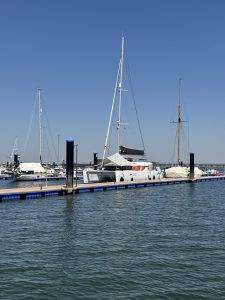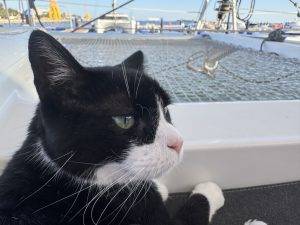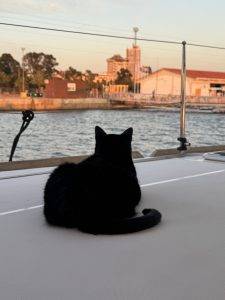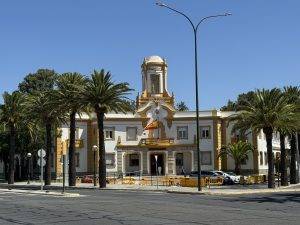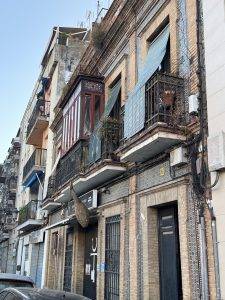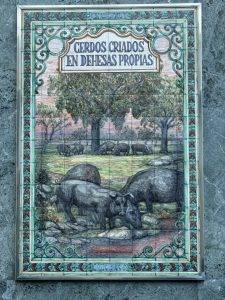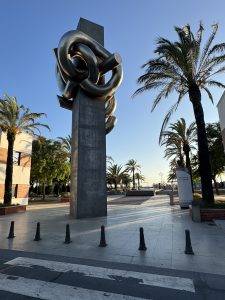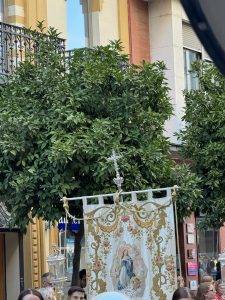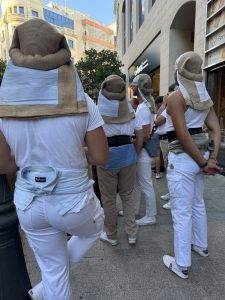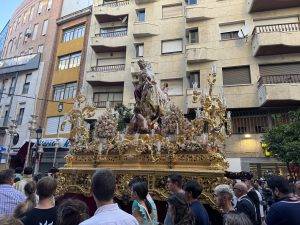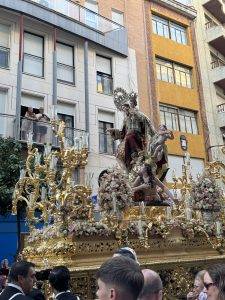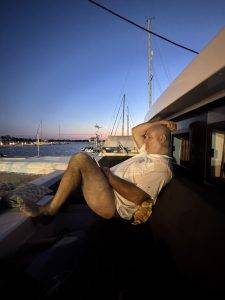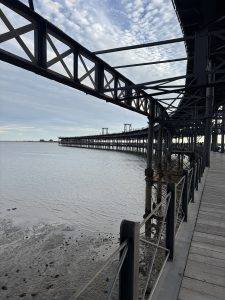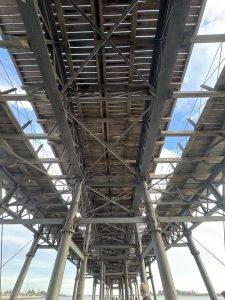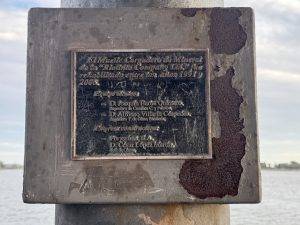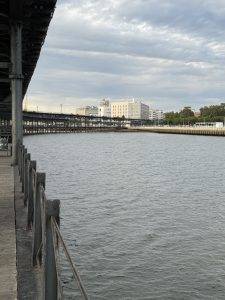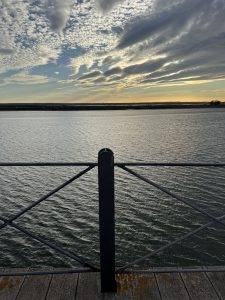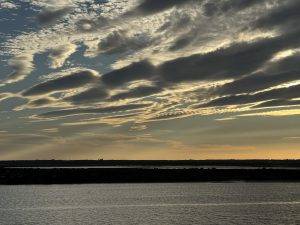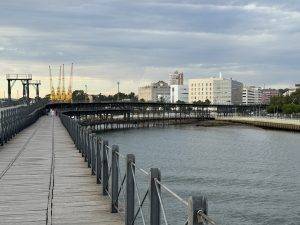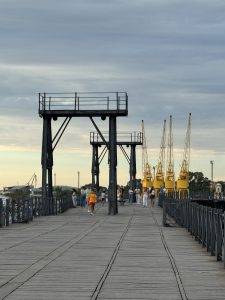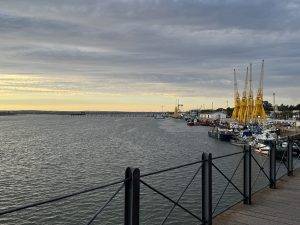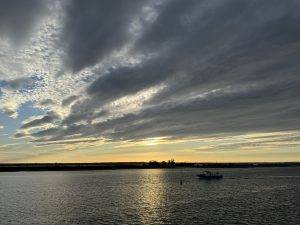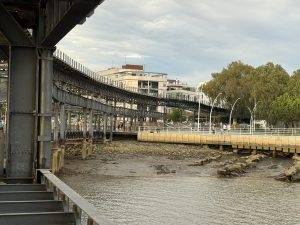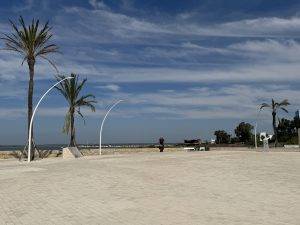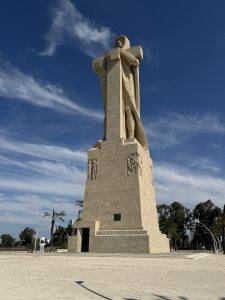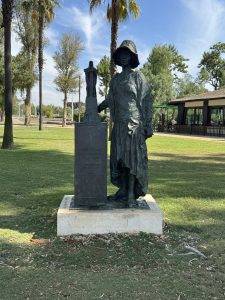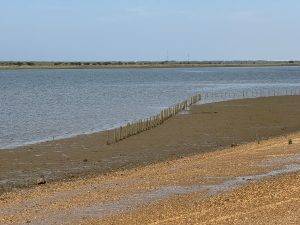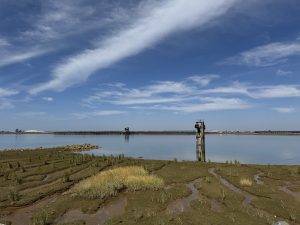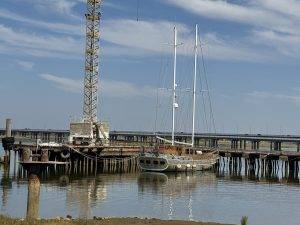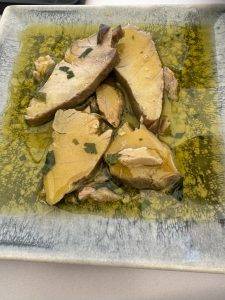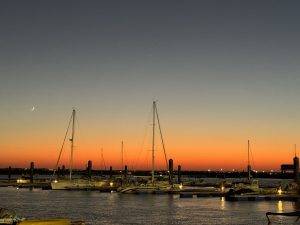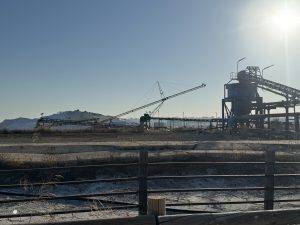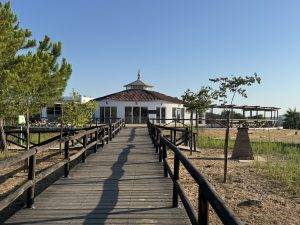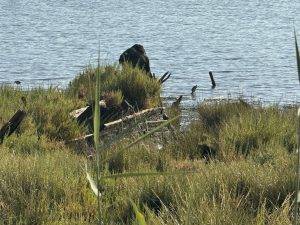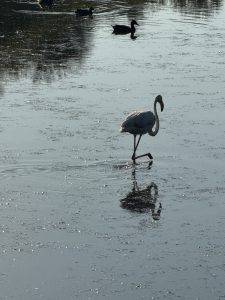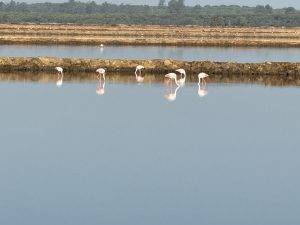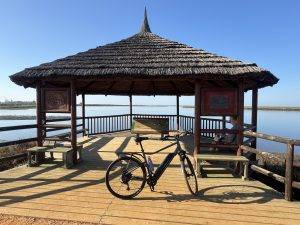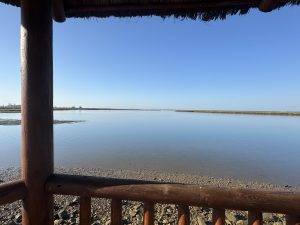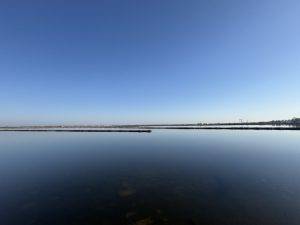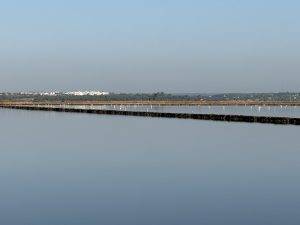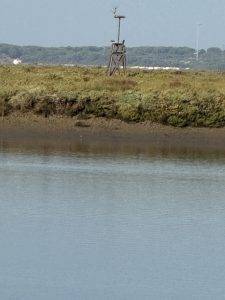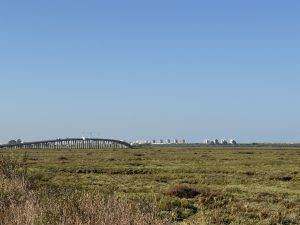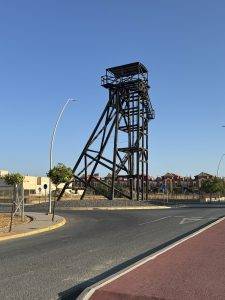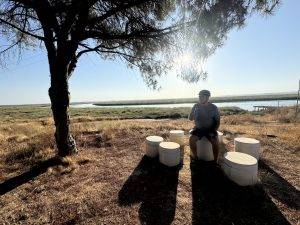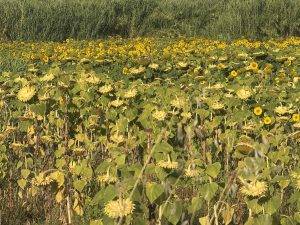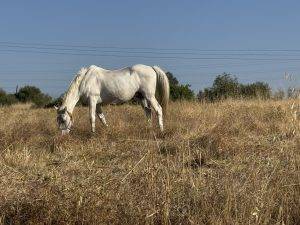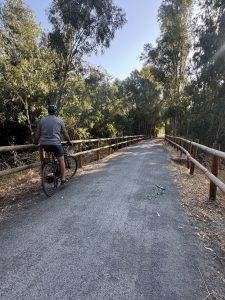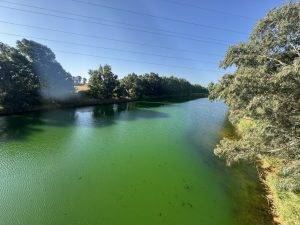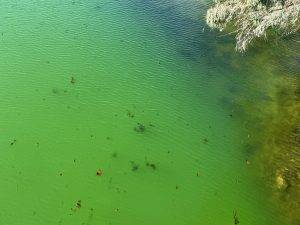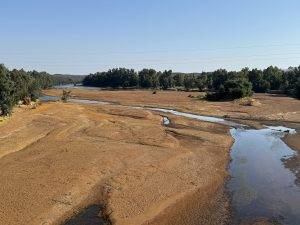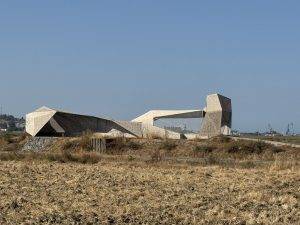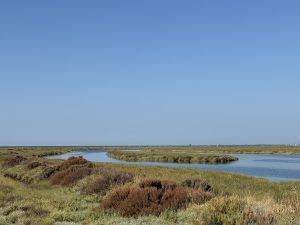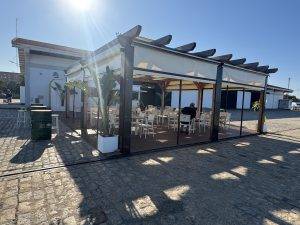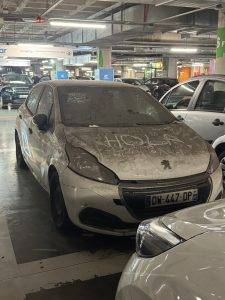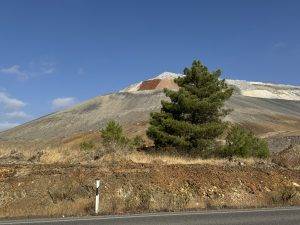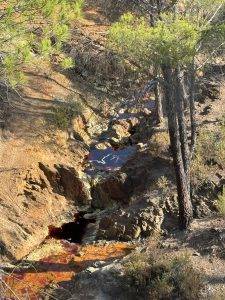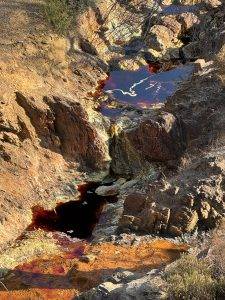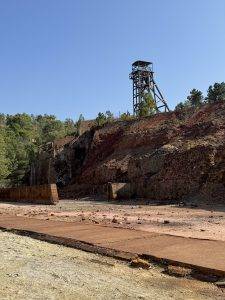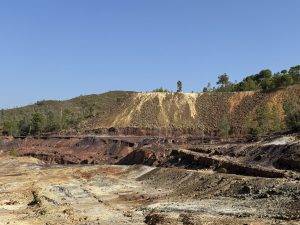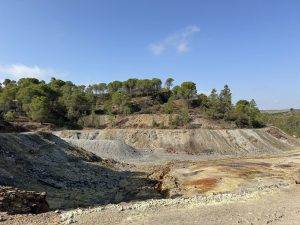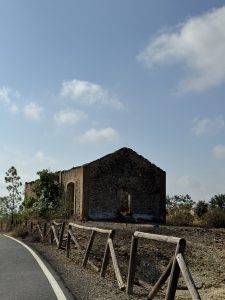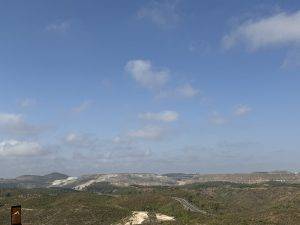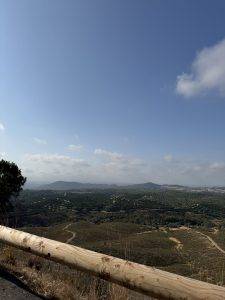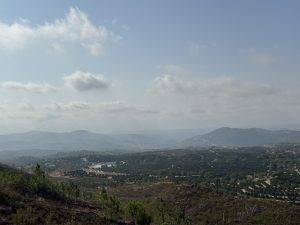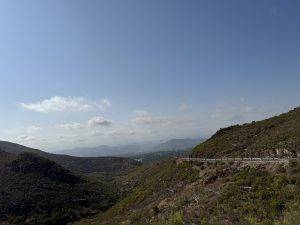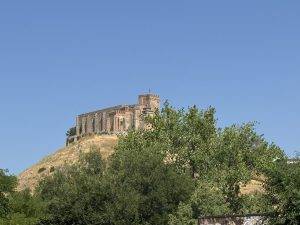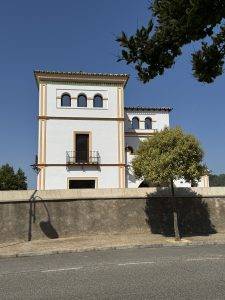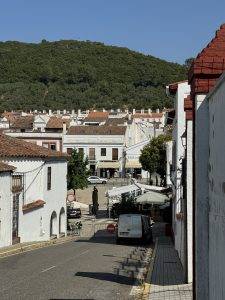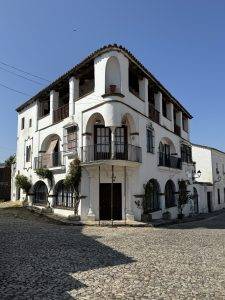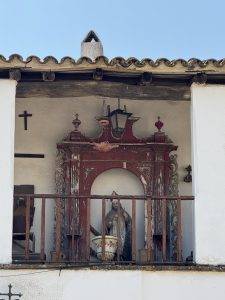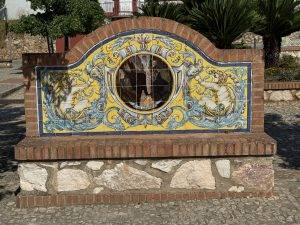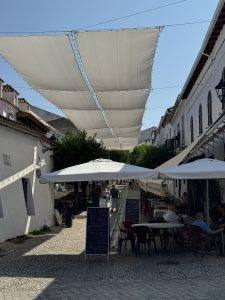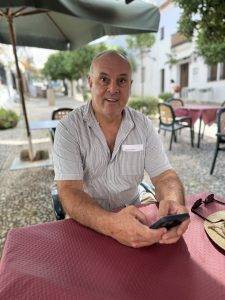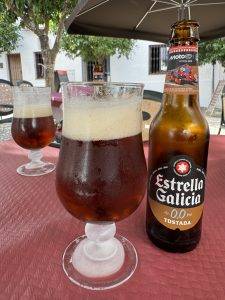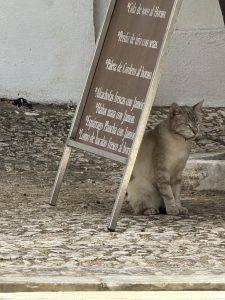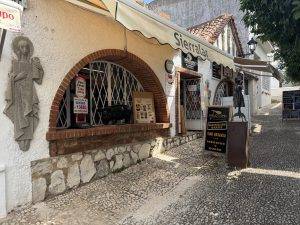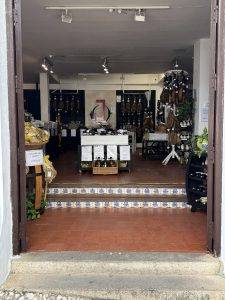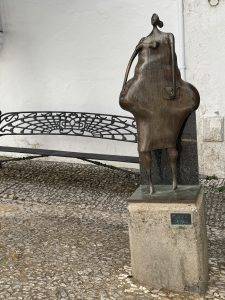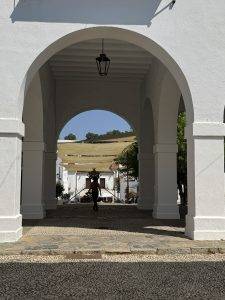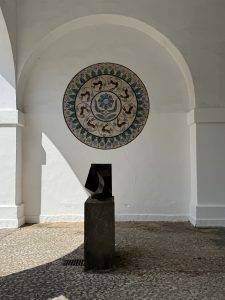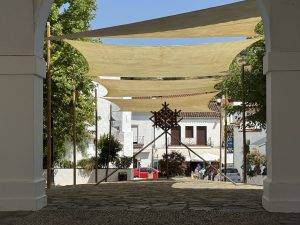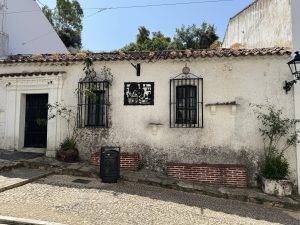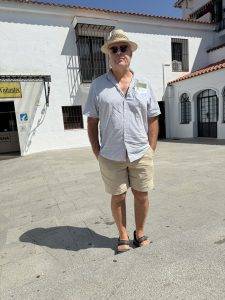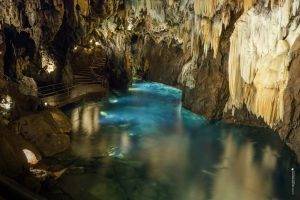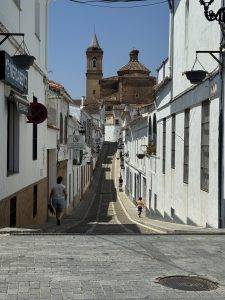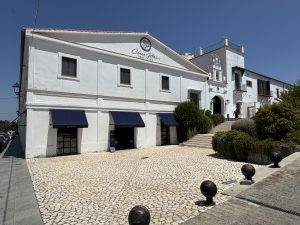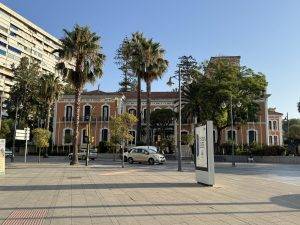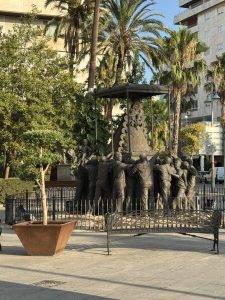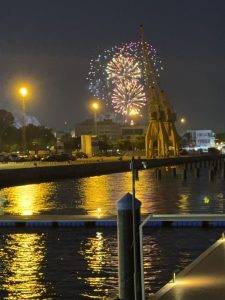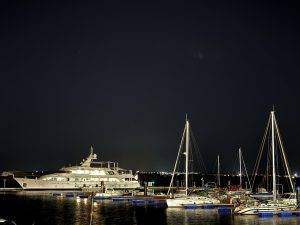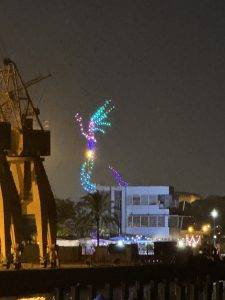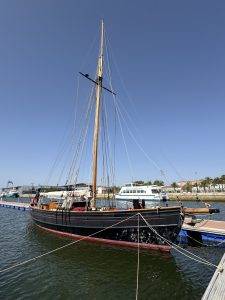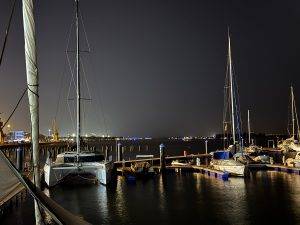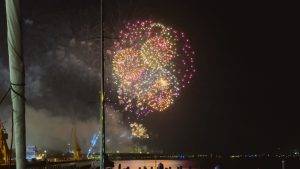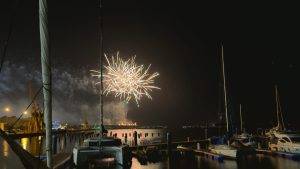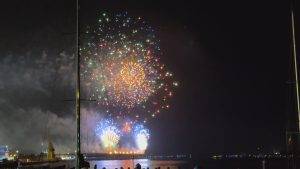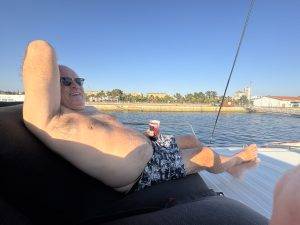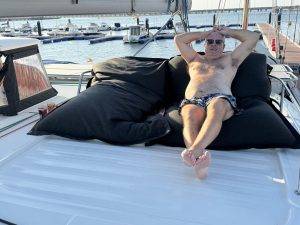After returning the rental car, everyday life has returned. Unfortunately, my bike still hasn’t been repaired, despite my inquiries. A spare part is missing, which won’t be delivered until the end of the month. It’s a shame, because we would have loved to go on a few bike rides over the next few days. But first, we have to tackle the tedious household chores such as laundry, vacuuming, and washing up. La Ola is also being thoroughly washed and polished on the outside. What has to be done has to be done! The Sahara dust that seems to be constantly blowing in from North Africa settles in every crack on the deck within a very short time. If it weren’t removed, you could probably grow potatoes on the deck after a while.
On July 16, the Virgen del Carmen, actually the Holy Virgin Mary of Mount Carmel, is celebrated in Andalusia. As the patron saint of fishermen and sailors, some of the processions in her honor take place on boats on the water. In Huelva, the celebration takes place two days later, and the statue of the saint is carried from the church in the city center to the Muelle del Río Tinto and back. We watch the procession for a while, because processions are simply part of the itinerary in Andalusia. In addition, as strictly superstitious sailors, we are of course obliged to take every opportunity to ask the authorities, whatever they may be, for good weather, calm seas, and the famous hand’s breadth of water under the keel. Which we do, of course. As pirates, we are also allowed to add a wish for gold, precious stones, or other riches. And, of course, we will be looking up at the constellation Perseus every evening for the next few weeks, hoping that our wishes will come true when we see a shooting star.
Back to the procession. With many dignitaries, music, and incense, it moves forward at a snail’s pace. The huge statue of the saint is obviously quite heavy and is carried by about a dozen strong men. Every few meters, the bearers are replaced. This way, every believer probably gets the honor of carrying the Virgin once, and at 30°C, which is still the temperature at 9 p.m., the strength is probably not enough for longer distances. The procession is accompanied by numerous believers. Anyone who can still walk manages to walk a few steps. Sometime after 10 p.m., the procession arrives at the Muelle del Río Tinto and there is a beautiful fireworks display. Unfortunately, the Virgin then has to be carried back to the church, where she is scheduled to arrive after midnight. You can find a video of the procession on Instagram.
Speaking of Muelle de Rio Tinto: the former loading pier of the Rio Tinto mining company is an industrial monument and one of the historic landmarks of the city of Huelva. From its construction in 1874 until its closure in 1975, it was considered a masterpiece of engineering. It was a „gravity loading pier.“ The gravity system consisted of arranging different entry and exit tracks for wagons so that the entry tracks rose to a peak, from where they descended to the end of the pier. With a switch, the wagons returned via the downward side tracks. This meant that unloading took place without mechanical drive, as the wagons were powered solely by gravity. Sounds like perpetual motion to me! After the mines were nationalized, the bridge fell into disrepair and was increasingly neglected. Once almost all the wooden parts had rotted away, it was decided to renovate the bridge and open it to the public in 2007. Since then, it has been a popular destination every evening, as it offers a particularly good view of the Marismas del Odiel and the sunset. After it was decommissioned, part of the bridge over the road below was also removed. After 50 years, this section has now been renovated and the bridge has been restored to its full length for a few days. The official inauguration is planned for the end of July. The Fiestas Colombinas are taking place in Huelva at the same time that weekend. It’s a kind of large folk festival, which we will probably go and see. Of course, we have to climb the structure and walk across it. Unfortunately, we haven’t figured out the timing for the sunset yet, but we can just as easily watch it from the ship.
After more than three weeks, I can finally pick up my bike from Decathlon. My neighbor Toby kindly drives me there again and brings me and the repaired e-bike back to the marina. The entire motor has been replaced and now works perfectly again. Fortunately, it was still under warranty, so there was no cost to me. The next day, we head straight to the Columbus Monument at the mouth of the Rio Tinto where it flows into the Rio Odiel. A beautifully landscaped footpath and cycle path runs along the riverbank for 6 km from the Marina del Odiel to the monument. A memorial dedicated to the artist was also unveiled this year. We take the same route back, but instead of stopping at the marina, we drive a little further to the Cantina del Puerto. With a view of the Odiel and the Muelle Tharsis, which was also used for ore transport, we enjoy a cool drink and a few tapas.
Another morning bike ride takes us back across the river to the Marismas del Odiel. This time we ride along the salt flats to the Puente del Burro. On the way, we stop briefly at the Anastasio Senra visitor center and watch the countless flamingos from the pavilion on Isla de Enmedio. Too far away and barely visible, there is an eagle’s nest, and with a sharp eye you can even see the two ospreys. Next time, we’ll have to bring a good camera with a long telephoto lens to get better photos.
We are increasing our cycling distances step by step and going on longer and longer tours. Next, we will cycle 35 km upstream along the Odiel River to Gibraleón and back. This may not sound particularly spectacular to keen e-bike or racing cyclists, but we usually cycle without electric assistance and I have hardly cycled at all in the last 30 years. The route to Gibraleón is beautifully varied and takes us over a bridge across the upper reaches of the Odiel, which impresses us with its vibrant green color. The bike route is mostly very well developed and mostly runs far away from the road along the nature park. This makes cycling really fun and we are happy to get up a little earlier for it. From noon onwards, the temperature rises above 30°C again, so we prefer to retreat to the shade of the cockpit.
We have now also planned the rest of our trip. We will stay in Huelva until mid-August, then leave the Río Odiel and head west again. We hope to spend a few nice days at anchor before moving to a berth in Olhão, Portugal, on August 20. Axel will then fly to Germany for a few days. During this time, I will be able to stock up on fresh ingredients from the market halls located right next to the marina. Fortunately, I won’t have to spend the days without Axel alone, but can spend the time with my „little“ niece Svea. So it’s going to be an exciting time! Once Svea is back in Germany and Axel is back on board, we’ll sail back and forth between Portugal and Spain and hopefully do a lot of anchoring and swimming. The wind and weather will decide exactly where we go. From November 1, we’ll be back in Vilamoura for the winter.
To ensure that we can enjoy the next few days at anchor, we rent a car for two days. This makes it easier to buy heavy items such as drinks and cat food for the next few weeks. At Carrefour, we also buy almost our entire supply of non-alcoholic wheat beer. In this heat, it’s simply the best drink to quench your thirst! We use the second day of the rental to take another trip into the hinterland. Now that the temperatures have cooled down a bit to 30°C, we want to visit Aracena and the Rio Tinto mines again. At a cool 22°C, we set off northwards at 8 a.m. As before, we drive slowly but steadily uphill until we reach the Rio Tinto mines. This time, we turn off into an older, disused mining area. Huge spoil heaps tower up like mountains. We pass old mining towers and wind our way along winding roads until we reach the source of the Rio Tinto. It is a small stream that we can see from above on the steep slope. The path down seems to have been washed away by the last rain. Nevertheless, the Rio Tinto glows a bright red, streaked with sulfur-yellow streaks. We continue past a museum in a disused mine. Our destination is a viewpoint a little higher up, but our Google Maps either overestimates the off-road capabilities of our rental car or has failed to notice that it has sent us onto a hiking trail. The gravel road is definitely not for us, so we turn back without having achieved anything. Google Maps continues to be sporty with us and sends us along the HV-5011 country road towards Aracena. The single-lane road winds its way up and down the mountain in tight serpentines. It’s a good thing that apart from a hiker and a cyclist, no one else is coming towards us! The nerve-wracking drive is rewarded with great views and beautiful scenery.
Finally, we reach Aracena and treat ourselves to a cool drink and some ham in one of the numerous restaurants. Then we head to the Gruta de las Maravillas, the Cave of Wonders. It is located in the center of town and is one of the most visited caves in Spain due to the diversity and richness of its formations. We have booked a guided tour in advance and are admitted punctually at 12:30 p.m. Much to my disappointment, photography is strictly prohibited in the cave. This is unfortunate, as I have brought my high-quality SLR camera with me especially for this occasion. Oh well… We are guided through the stalactite cave by a friendly lady who unfortunately only speaks Spanish for just under 45 minutes. It was discovered in 1850 during mining work and has been open to the public since 1914. The tour takes us about 1.2 km through various caves, where we can see countless stalactites (hanging from above) and stalagmites (growing upward from below). The Great Hall is impressive, with a height of 50 m and a crystal-clear lake, whose well-filtered water is perfectly drinkable. We are thrilled by the diverse geological formations and can highly recommend a visit here. Contrary to our assumption that it would be pleasantly refreshing underground at 16-19°C, we emerge back into daylight drenched in sweat. This is not only because there were numerous steps to climb, but above all because of the extremely high humidity of 98%. In addition, the corridors are not necessarily designed for North German body sizes, so we have to bend down to pass through many passages. Once back in the sun, we continue on our way. We drive to Jabugo, the ham capital. Unfortunately, we arrive just in time for lunch, so almost all the shops are closed. Luckily, we find one shop that is still open and can replenish our supplies of Jamon Jabugo. Finally, we head back to Huelva, where we arrive in time for a little siesta and an ice cream on board.
After hearing a loud „F*ck, F*ck, F*ck“ from our neighbors on the Carlotta on Wednesday, we spontaneously decide to get our diving gear ready. Sam dropped her brand new iPhone in the water while caulking the hull, and Toby tries to dive for it after I point out that iPhones are waterproof for a while. First without equipment, then with our diving gear. But with the tide coming in and poor visibility, there’s nothing we can do at high tide. The next day, Toby tries again at low tide and actually finds it. And – the iPhone still works. The day is saved!
There is also plenty of entertainment in Huelva. Every year at the end of July/beginning of August, the Fiestas Colombinas take place in Huelva, and we are right in the middle of it all. Here is some information about this Andalusian folk festival: The Fiestas commemorate various historical events surrounding the discovery of America. August 3 is the most important day of the week-long festival, celebrating the departure of Columbus‘ expedition from Palos de la Frontera to America in 1492. Access to the grounds is through a gate that imitates an important building in the city or province. This year, it is the facade of the Centro de Instrucción Comercial. The site covers 130,000 square meters and has over a hundred festival tents that are open to the public free of charge. Before the official start on July 30, there is an unofficial start with a lighting test on the evening before. And of course, fireworks are a must in Spain on such occasions. And because it’s so beautiful, there are two fireworks displays to marvel at. One for the official opening on July 30 and one on August 4. But that’s not all! On August 3, there will also be a drone show. Last but not least, around 600,000 visitors are expected. So it could get crowded! But mass events aren’t really our thing. To make matters worse, the event doesn’t start until 10 p.m. By then, we’re usually already in bed. So we can’t bring ourselves to go, but will just watch the pyrotechnic and drone displays from afar. We have the best seats in the house for the fireworks and drone show from our roof terrace in Marina del Odiel. And to make sure we’re comfortable, we’ve invested heavily and bought two Fatboy beanbags. Super comfy! Even without fireworks, it’s a great place to enjoy a sundowner in the evening sun.
A great end to our stay in Huelva. We really enjoyed our time in Marina del Odiel. Huelva is definitely worth a visit and we hope to be able to see the completed marina in a few years‘ time. But now it’s time for us to move on.

